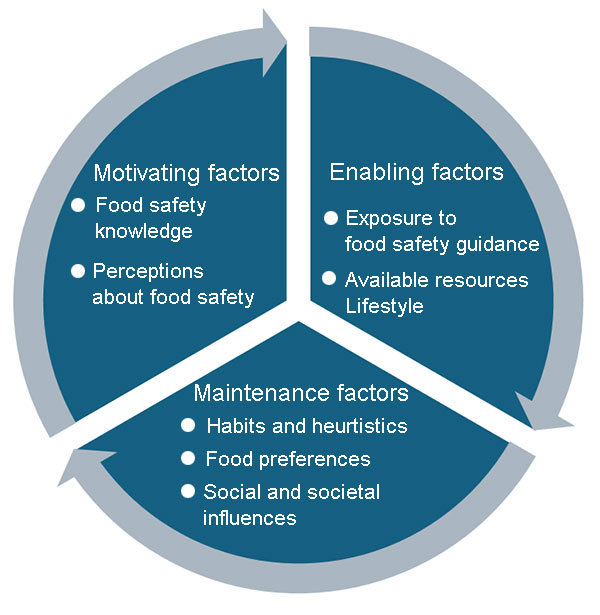Brita Ball, Food Safety culture expert, Canada
Food safety continues to be a problem in Vietnam, with many people becoming ill from contaminated food. Recent studies show that such illnesses are often related to consumer behaviours and beliefs. This burden on families throughout the country can be reduced by improved food safety culture in Vietnamese households.
Vietnamese researchers[1] recently investigated factors that influence consumers’ food safety behaviour. Their results highlighted the importance of focusing interventions on local norms and household situations which hinder the adoption of safe food handling practices. As food safety specialist who has studied consumer behaviour and food safety culture in Canada, I believe their findings can help understand food safety culture in Vietnam.
The researchers discussed the following four factors that influence Vietnamese consumers’ food handling practices:
1) Maintaining factors – These factors relate to cultural norms that may prevent people from following food safety practices even though they are aware of them.
- Habits and heuristics – Habits and assumptions are hard to change because people often do not know what they are. Some of these include unsafe habits, like not storing leftovers in the refrigerator based on the assumption that no one got sick yet.
- Food preferences – Many Vietnamese prefer traditional foods because of the familiar flavour, texture and appearance. Unfortunately, some traditional foods have a high food safety risk. For example, raw blood, raw fish and other seafoods, raw or undercooked meats, and undercooked eggs may have high levels of bacteria, viruses or parasites.
- Social and societal influences – Family and friends and local norms that support unsafe food choices and unsafe practices increase food safety risk. Consuming unknown plants and mushrooms, local herbs, sea snails, fish and other seafood may seem safe, but some contain high levels of natural toxins that cannot be removed by cooking.
2) Demographics – These factors relate to consumer characteristics that influence knowledge about food safety.
- Age – Older people are more aware of the importance of safe food than younger people. This may be due to elders’ understanding that they are more susceptible to illnesses as they get older.
- Gender – Women are more aware of food safety risks than men. This may be because they are often responsible for food preparation, and for caring for elders and children who can get sick easily. Women are also at greater risk of infections when they are pregnant.
- Education – Several studies suggest that people with higher education are more aware of food safety practices than those with less education. Office workers, for example, know more about food handling practices than manual labourers.
3) Motivating factors – These factors are provide the foundation for changing behaviours:
- Knowledge about causes of foodborne illness and safe food handling practices motivates people to avoid doing things that increase food safety risk and to do things that reduce the risk.
- Perception of food safety risks, the seriousness of foodborne illness and the benefits of good food safety practices can motivate people to improve their behaviour. Bacteria, virus and parasites are the most common causes of foodborne illnesses and can often be controlled by good food safety practices. Unfortunately, some consumers mistakenly believe that chemical contamination is the biggest food safety risk, and some do not believe scientific facts. Their risk perception leads them to take chances with unsafe food choices or practices.
4) Enabling factors – These factors make it easier for motivated consumers to follow proper food handling practices.
- Exposure to food safety guidance while managing home prepared meals: People will be able to follow proper guidance if it is available when they need it. This includes having accurate food safety information while they are planning and preparing meals and storing ingredients or leftovers.
- Availability of proper resources: People who have the tools, space and other resources will be able to follow recommended food safety practices. Those without running water, adequate space and a refrigerator may find it hard to prevent cross-contamination while preparing food and prevent bacteria growth but should do the best they can.
- Lifestyle that influences food selection and cooking: People who have adequate time are able to shop often and cook family meals. Those with time and other constraints may buy more food when they shop and store it at home, instead of going to the market every day, and they may buy more “box meals” or convenience foods. Everyone should keep perishable food refrigerated and buy meals prepared by people who follow safe food handling practices.
Food safety culture in the home can be improved by considering the three changeable contextual factors shown in the diagram: maintenance, motivating and enabling factors. When people become aware that some traditional practices (maintenance factors) may be unsafe, they can begin making decisions to reduce the risks. Learning about the causes of foodborne illnesses and proper food safety practices (motivating factors) can increase motivation to change. Finally, increasing factors that enable the adoption of new behaviours (enabling factors) will reduce food safety risks, especially to the elderly, pregnant women and children who are most susceptible to becoming ill. When new habits and beliefs about food safety become common practice, they will be the new maintenance factors.
What habits, assumptions and beliefs are you willing to change to reduce food safety risks and improve food safety culture at home?




Photo source: Dien May Xanh

